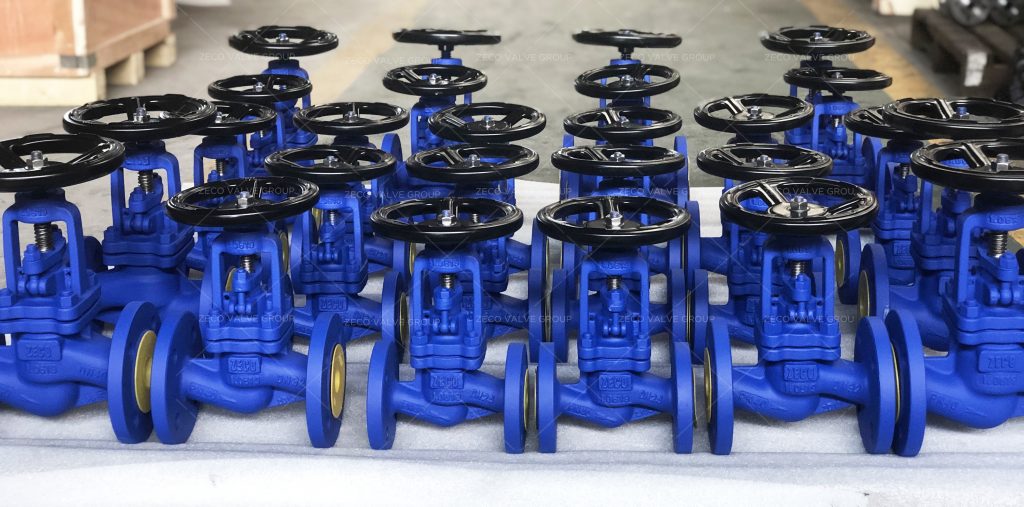What is a Globe Valve?
To decide if a globe valve is right for your application, consider its three core features. First, they are lateral movement valves, which means they open or close based on the up-and-down movement of a stem. Second, they allow, stop, or throttle fluid flow. Some valves have only open and closed states, but globe valves can throttle flow without totally stopping it. Third, they cause significant head losses compared to other valves, a tradeoff for the throttling services.
How does a Globe Valve work?
From the outside, globe valves have three parts, a handwheel, a bonnet, and a body. The bonnet houses a stem, and when the handwheel is turned, the stem screws up and down in the bonnet. The end of the stem has a small component called a disk or plug, which can be metallic or non-metallic and may come in different shapes, depending on the need.
The globe-shaped body for which the valve is named houses a seat. The seat is a metal frame that divides the body into two chambers and has a hole to allow fluid to pass. When the valve is open, fluid flows up through the opening in the seat. To close it, the stem is screwed down until the disk blocks the seat’s opening.
Advantages and Disadvantages of globe valve

- One of the main advantages of globe valves is their ability to throttle or modulate flow. Besides being closed or open, they can also be partially open. This allows you to adjust flow without totally stopping it.
- During opening and closing, the disc is wear-resistant because the friction between the disc and the sealing surface of the body is less than that of the gate valve.
- Usually, there is only one sealing cover on the valve body and disc, so the manufacturing process is better and more convenient for maintenance.
But, the drawback of the stop valve also cannot ignore.
- The disadvantage of globe valves is the comparatively significant head loss they create. Head loss, also called pressure loss, refers to the amount of resistance a liquid encounters as it flows through pipes. The more resistance, the more pressure that is lost. Gravity, friction (of the fluid against the walls of the pipe), and turbulence all cause this loss. Valves and fittings cause pressure loss mainly through turbulence.
- Open height is generally only l/4 of seat channel diameter, so it is much smaller than the gate valve.
- The main disadvantage is that the flow resistance coefficient is relatively large, so pressure loss is caused, especially in the hydraulic device, such pressure loss is particularly obvious.
Globe valve vs Gate valve
There are several alternatives to the globe valve, and understanding the different options can help you pick the right valve for the job. Two major alternatives to the globe valve are the gate valve and the ball valve. First, let’s consider the differences between globe and gate valves.
Gate valves, like globe valves, are linear-motion valves. They are opened and closed by turning a handwheel that screws a stem in and out of the bonnet. When a gate valve is closed, an obstruction is pushed down by the stem perpendicular to the path of the fluid.
Unlike globe valves, gate valves don’t require fluid to change directions—the flow path is straight. As such, gate valves cause very little head loss (L/D=8). However, they do not throttle as well as globe valves—the fluid flow rate in a gate valve is not proportional to how open the valve is at any moment.
Globe valve vs Ball valve
There are many different types of valves for different applications, so how do you know which is the best to use for your application? Let’s look at globe valves and ball valves. The main difference between these two types is the way they are close. A globe valve uses a plug (stem) that closes against the flow, and a ball valve has a gate (ball) that closes across the flow. Globe valves are good for regulating flow, whereas ball valves are better for on/off control without pressure drop.
For decades globe valves were considered the industry standard in control valves. They are designed with a stem that moves up and down inside the valve to control flow. They are commonly used on hot and chill water coils, and larger models are often used to control flow to chillers. One of the main limitations of globe valves is that their close-off rating can be lower than other valves, especially in larger sizes.
Since ball valves don’t force water to change direction, they create very little head loss (L/D=3). As with gate valves, this low-pressure loss comes with the tradeoff of little throttling capability. Ball valves are either open or closed, with little in-between.
We are Globe Valve Manufacturers. If you have demand about our products, Welcome to our website know more details. Maybe there are the products such as DIN Gost Gate Valve you need.
Related Tags :
Ten articles before and after
How Does The Ball Valve Stand Out In The Valve Arena?
Butterfly Valve Transportation and Storage and Other Major Matters
Check These Before Installing The Valve
The Applications Occasion of Globe Valve
How Does the Valve Perform Routine Maintenance?
Check Valve Installation Precautions
Advantages, Disadvantages And Types of Valve Gate












